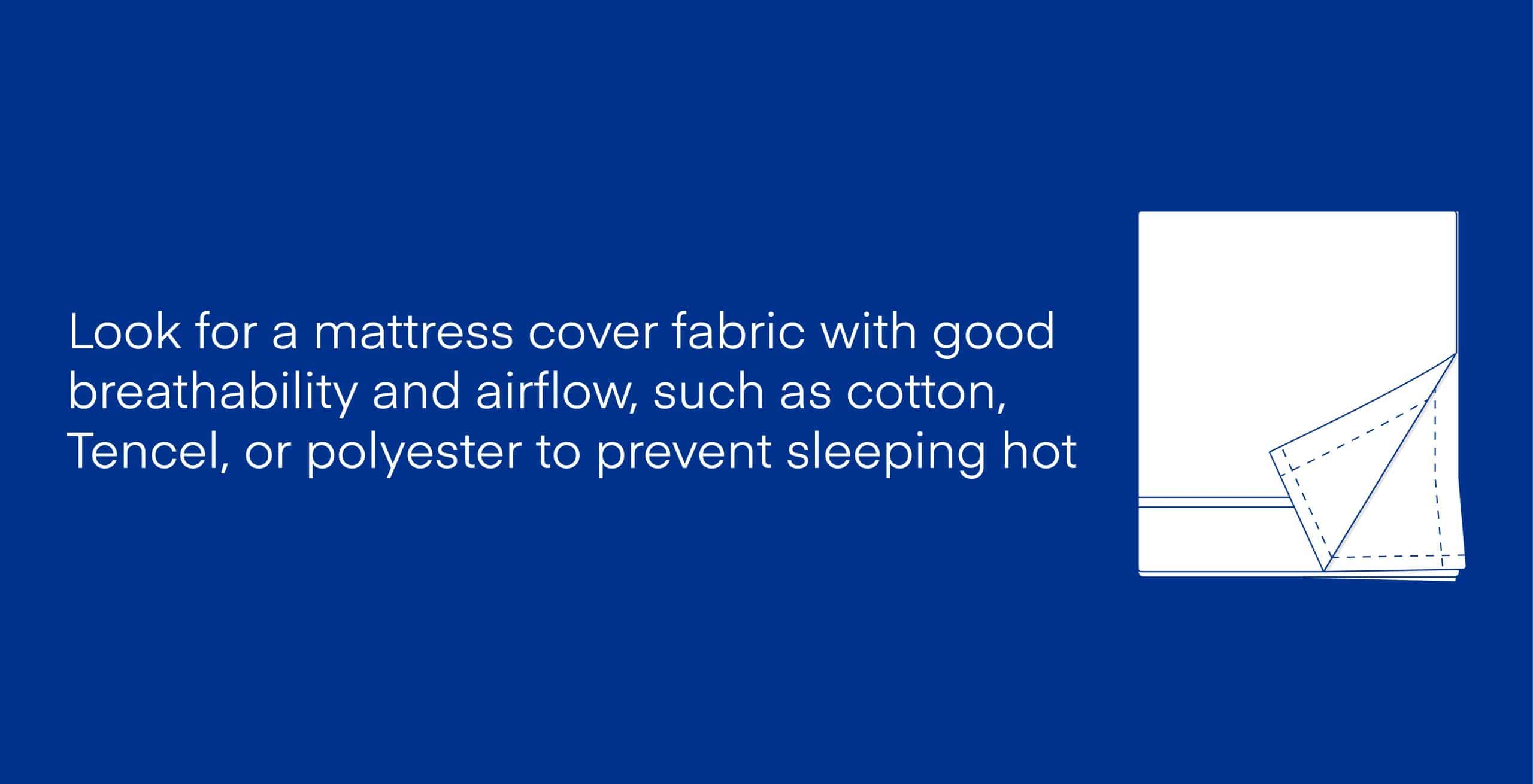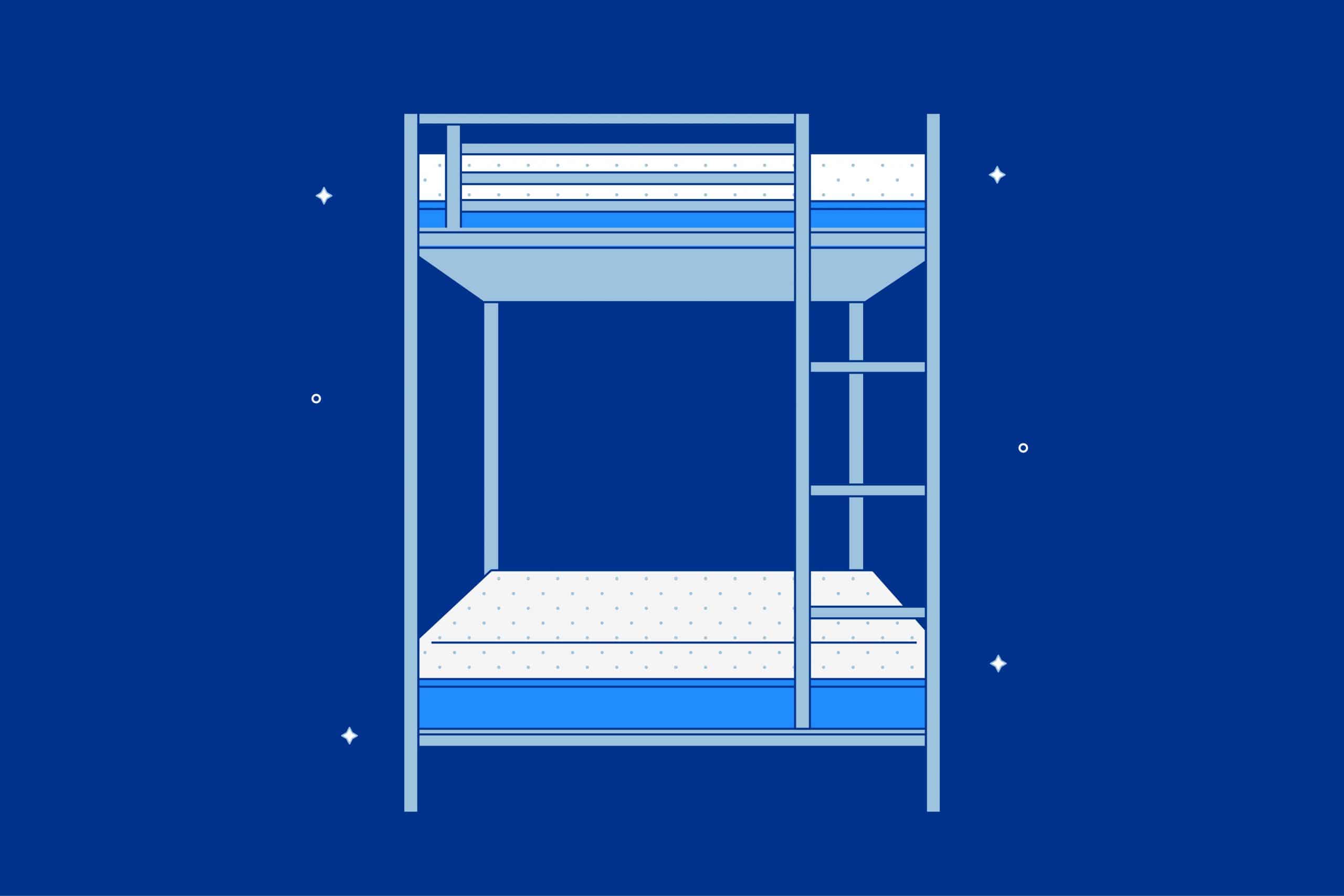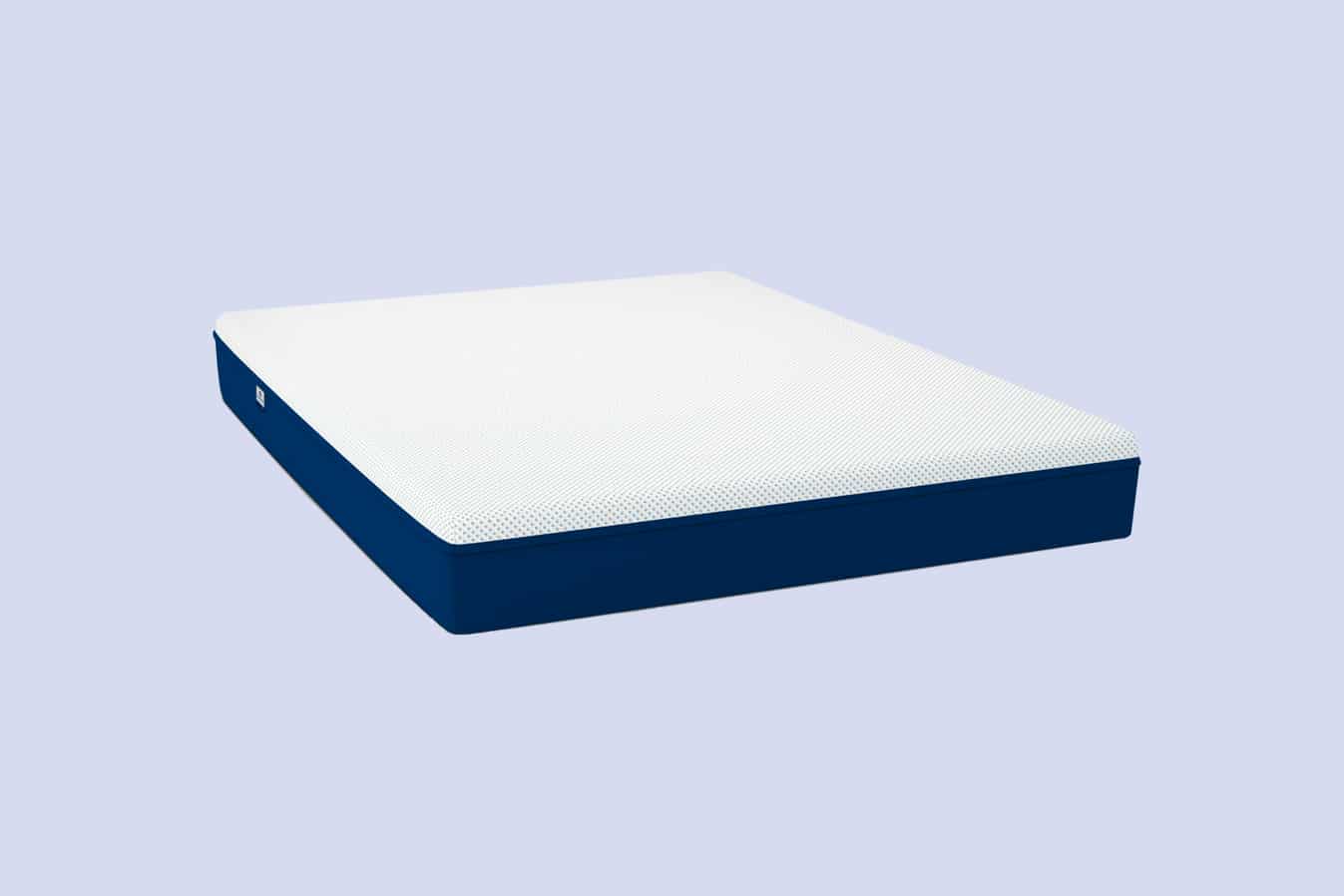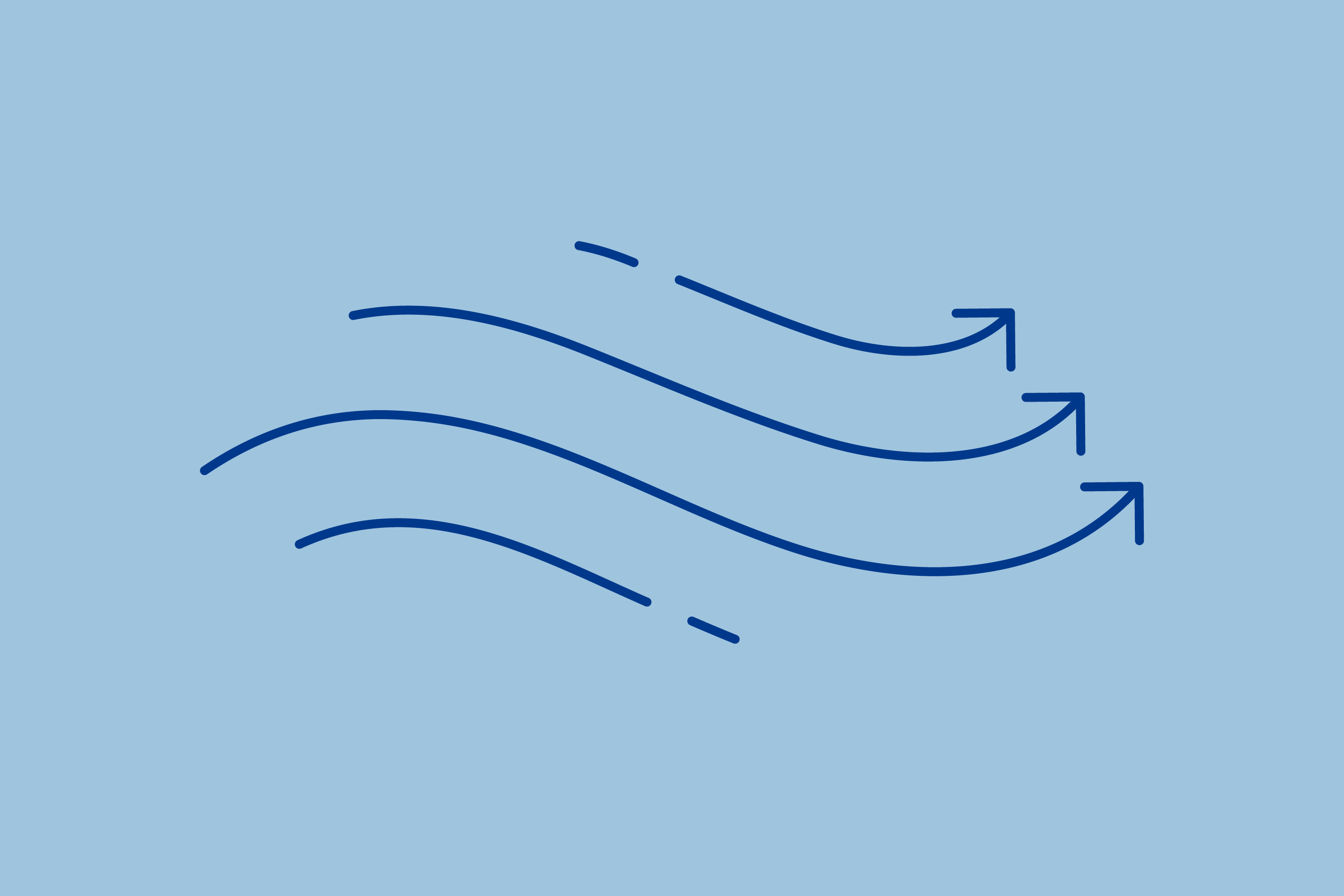Bunk beds were once just for kids at summer camp, but nowadays, they’re great for any single adult or family looking to maximize their living space. Bunk beds are commonly used in small homes, dormitories, and children’s bedrooms.
Although bunk beds fit standard mattress sizes, they typically need to be thinner and lighter than a regular mattress so you can safely on them. The hunt for a supportive, comfortable, yet lightweight and low-profile mattress can be hard, so we’ve summed everything you need to know about bunk bed mattresses along with our top mattress picks.
Let’s take a look at some of the best bunk bed mattresses.
Best Mattresses for Bunk Beds
Quick Guide: A 30-Second Summary
| Best Firm Bunk Bed Mattress | Amerisleep AS1 |
| Best Bunk Bed Mattress for Back Sleepers | Amerisleep AS2 |
| Best Bunk Bed Mattress for Side Sleepers | Amerisleep AS3 |
-
Mattress Type
Memory Foam
-
Firmness
8 to 9 out of 10 (Firm)
-
Availability
All sizes
-
Warranty
20 Years
-
Thickness
10 Inches
The AS1 is our firmest mattress model and best suited for stomach, back, and heavyset sleepers who need lots of support.
Despite being nice and firm, the top layer of our mattress has 2 inches of Bio-Pur®, our plant-based comfort foam, for light cushioning and pressure relief. To make Bio-Pur®, we partially replace some of the petroleum, the chemical used in memory foam, with castor oil. Not only does this help you sleep cooler, but it’s better for the environment and your health.
At the base of the AS1 is 8 inches of Bio-Core®, a polyurethane foam built to promote neutral spinal alignment and prevent sleepers from sinking at night.
All the foams used in our mattresses are CertiPUR-US® certified, meaning they’re free of phthalates, formaldehyde, CFCs, and PBDEs. They’re also low in VOC emissions, to minimize off-gassing, or that chemical smell when you first open your new mattress.
The AS1 is available in all standard mattress sizes, including twin, twin XL, and full. Since the AS1 is our thinnest mattress, it’s also quite lightweight. The twin weighs 45 pounds, the twin XL weighs 49 pounds, and the full weighs 63 pounds.
-
Mattress Type
Memory Foam
-
Firmness
7 out of 10 (Medium-Firm)
-
Availability
All sizes
-
Warranty
20 Years
-
Thickness
12 Inches
Our second firmest model is the AS2. The medium-firm mattress is great for back, stomach, and plus-sized sleepers who want just a bit more cushioning than they would receive on the AS1.
The AS2 has 2 inches of Bio-Pur® and 7 inches of Bio-Core® to maintain the mattress’s support system without adding extra height to the bed.
Between the Bio-Pur® and Bio-Core® is the 3-inch Affinity layer with HIVE® technology designed for zoned support. This transition layer supports the lumbar spine, evenly distributes weight, and promotes better spinal alignment.
The AS2 is just a bit heavier than the AS1 since it’s thicker, measuring 12 inches. The twin weighs 49 pounds, the twin XL weighs 53 pounds, and the full weighs 68 pounds.
-
Mattress Type
Memory Foam
-
Firmness
5 to 6 out of 10 (Medium)
-
Availability
All sizes
-
Warranty
20 Years
-
Thickness
12 Inches
The AS3 is our most popular model. It’s a medium, making it the ideal choice for side, combination, and petite sleepers (like children).
The mattress is 12 inches thick and has 3 inches of Bio-Pur®, 2 inches of the Affinity layer, and a 7-inch Bio-Core® base. The extra inch of Bio-Pur® in the AS3 versus the AS2 or AS1 increases the mattress’s conformity and contouring potential.
The AS3 is another one of our mattresses available in as the AS3 Hybrid for sleepers in need of extra bounce. It has 8 inches of pocketed coils and a thin base foam in the place of the Bio-Core® base.
The AS3 twin model weighs 53 pounds, the twin XL weighs 57 pounds, and the full weighs 73 pounds.
All our mattresses are proudly made in the USA. They come with a 100-night sleep trial and a 20-year warranty for workmanship defects and sags beyond an inch. We also offer free shipping and hassle-free returns within the continental US.
What to Look For in a Bunk Bed Mattress
Regardless of if your bunk bed is for you or your child, finding the right mattress ensures you can have a safe and good night’s sleep. Let’s take a look at some points to keep in mind when searching for a bunk bed mattress.
Thickness
Although standard-size mattresses fit in bunk beds (suggesting any mattress will work on a bunk bed), a mattress’s thickness is incredibly important to keep in mind for bunk beds.
The height of your mattress affects your headroom on both the top and bottom bunk. There are also specific safety guidelines regarding mattress thickness and the top bunk—the top of the mattress should be at least 5 inches shorter than the guardrails.
The top bunk mattress shouldn’t be more than 6 inches thick unless you have uniquely-tall guardrails. Too tall of a mattress and it’ll extend past the guardrails, leaving the top bunk sleeper at risk of falling.
A thinner top bunk mattress also makes it easier to make the bed and switch out the bedding since the mattress is lightweight. After all, imagine trying to make the top bunk bed or change your sheets while balancing on a ladder! It’s not only awkward but unsafe.
While there are no specific safety guidelines for the bottom bunk’s thickness, a thicker mattress minimizes your amount of headroom. Even if the bed is for a small child, if you’re tucking them in at night, being able to sit comfortably in their bed is nice. For this reason, an 8 to 12-inch mattress is ideal for the bottom bunk.
Some shoppers may worry a thinner mattress may be uncomfortable, however, you can find high-quality and comfortable low-profile mattresses. Still, grown adults may not find a 4 to 6-inch mattress supportive for long-term use. Adult bunk bed users should use the lower bunk or find a bunk bed with tall guardrails and a higher weight capacity so they can safely use a thicker mattress.
Firmness
Choosing the right mattress firmness is essential for your comfort and sleep quality.
Younger children need firmer mattresses to ensure they’re not at risk of suffocation. Let older children and teens find a comfortable mattress based on their sleeping position and size. Adults should also choose a mattress suited for their sleeping position and size.
The best mattresses for back sleepers are medium to medium-firm mattress since they need to prevent their lower back from sagging, causing pain.
The best beds for stomach sleepers are medium-firm to firm. The extra firmness keeps their hips level with the rest of their body, preventing pain and ensuring their spine is aligned.
Mattresses for side sleeping are typically medium or medium-soft mattresses. These sleepers need extra softness to cushion their hips and shoulders (the widest parts of the body) and prevent pressure points.
Combo sleepers usually do best on a medium mattress since it’s a good middle-ground for all sleeping positions. It’s firm enough to make switching positions easier but soft enough to cradle the curves.
Mattress firmness ratings are based on the average-sized adult who weighs between 130 to 230 pounds. Petite sleepers (including children) who weigh less than 130 pounds should choose a mattress slightly softer than what’s recommended for their sleeping position.
Plus-sized sleepers who weigh over 230 pounds should find a firmness slighter firmer than what’s recommended for their sleeping position. This way, different body types can still enjoy the proper pressure relief and spinal alignment from their mattress.
Mattress Size
The typical bunk bed isn’t just for twin mattresses these days. While you can still find twin bunk beds, you can also find them in other standard mattress sizes, including twin XL, full, full XL, and even some king and queen sizes.
Twin bunk beds (38 by 75 inches) are still a great option for children who share a room. However, twin and twin XL mattresses are slightly different. Twin XLs are 5 inches longer than standard twins, so they work well for taller teens and adults. They’re common in dormitories and studio apartments, as well.
Full mattresses (54 by 75 inches) are quite wider than twin beds but are still best for a single sleeper long-term. They can also work for children who are having a sleepover and need to share a bed for a night. Similar to a twin XL, full XLs are just the longer version of a full bed and suit taller teens and adults.
While you can find king (76 by 80 inches) and queen (60 by 80 inches) bunk beds, they’re fairly uncommon. King and queen mattresses are usually just the bottom bunk while the top bunk frame fits any of the smaller mattress sizes previously mentioned.
King and queen bunk beds are rare because they only fit in large master bedrooms, but people with large master bedrooms are usually grown adults or couples who share a bed. It’s unlikely couples would want to share a bed with a third person or have a bunk bed in the first place. And although some adults may need a bunk bed, if they have lots of space and can afford a king or queen mattress, they likely won’t need or want a bunk bed.
Weight
Bunk beds have a specific weight capacity to ensure they can be used safely and effectively. Weight capacities will vary depending on the brand you buy the bed frame from, but here’s what you can expect.
Top bunks have a stricter limit n regarding how much weight you can put on them since they’re higher up. Child-specific bunk beds can only carry between 150 to 220 pounds, and adult bunk beds can carry between 250 and 800 pounds.
Since bottom bunks are low to the floor, their weight capacities are akin to those of standard mattresses and bed frames. So, you won’t have to worry as much about how much the bottom bunk’s mattress weighs.
Realize that weight capacities include both the weight of the mattress and the sleeper, so look for lightweight mattresses when shopping and consider how large the bunk bed user will be.
Noise Potential
When sharing a bed, even indirectly on a bunk bed, consider the potential noise. You may end up sharing a room with a snorer, sleep-talker, or someone who has nightmares or night terrors.
It’s helpful to know somebody’s sleep habits before sharing a bedroom with them. But if need be, earplugs are an easy solution to drown out any noise.
While noisy mattresses were once a common concern, most modern mattresses are rather silent. Instead, your bed frame might be noisy, especially if it’s old or any screws are loose. Cheap or old wooden bunk beds can creak, while metal bunk beds can squeak. Ideally, search for a durable and high-quality bunk bed frame so there’s no potential of squeaking.
Fabric
Breathability is important when sleeping multiple people within close proximity. Look for a mattress cover fabric with good breathability and airflow, such as cotton, Tencel, or polyester to prevent sleeping hot.

If you have children, a zippable, removable mattress cover is smart in case your children spill food or have an accident. You should use a mattress protector at all times to keep your mattress clean and prevent voiding the warranty.
Price
Most bunk beds are twin beds, so they use fewer materials, and are thus less expensive compared to larger mattress sizes.
Lots of bunk beds are inexpensive, though they don’t last very long. Many people aren’t willing to invest in bunk bed mattresses because they expect their children to grow out of them.
However, if you want your bunk bed to last a long time without sagging, invest in a higher quality mattress. If the bunk bed is for your child, remember you can eventually switch them out of their bunk bed but continue using the mattress.
Types of Bunk Bed Mattresses
Each mattress type has its pros and cons, though your decision may come down to personal preference. Still, the type of mattress you use for a bunk bed is important because it determines how much you pay and the mattress’s durability, weight, and performance.
Memory Foam
Memory foam is a popular mattress type known for its pressure relief and superb motion isolation. Memory foam mattresses conform well to the body without sagging, and evenly distribute body weight. All-foam mattresses are generally lightweight, so they work well on a bunk bed.
Traditional memory foam traps heat, so many companies have designed their own versions of memory foam, including plant-based, charcoal, and cooling gel memory foam. New takes on memory foam are more durable, cooling, and sustainable compared to traditional memory foam.
Latex
Latex mattresses are similar to memory foam, but they’re bouncier and even more durable. They conform to your body well, promoting pressure relief without causing you to feel trapped inside your bed.
Latex is made from the sap of rubber trees, making it a more eco-friendly option for sustainable shoppers. Also, it’s naturally hypoallergenic, so kids with allergies can sleep comfortably. But as a result, latex models are more expensive than other foam mattresses.
Innerspring
Innerspring mattresses are becoming a thing of the past. The once majorly popular mattress has a coil support system and pillow-top comfort layer made from down, cotton, or foam. While innerspring mattresses are inexpensive and provide excellent airflow and support, they’re rather uncomfortable, noisy, and heavy.
While innerspring and hybrid mattresses both have a spring coil base, most people prefer the pressure relief found with a hybrid.
Hybrid
Hybrid mattresses are an upgraded version of innerspring beds. They’re more quiet, durable, and comfortable overall. Hybrid mattresses have a coil support system and foam comfort layer for an all-around supportive and comfortable bed.
While you get the pressure point relief of memory foam or latex, you also get the bounce and airflow of an innerspring bed.
Keep in mind, hybrid mattresses are pricey. Also, due to their complex construction and materials, hybrid mattresses can get a bit heavy, so check the mattress’s weight and your bunk bed’s weight capacity before buying.
Types of Bunk Bed Frames
Bunk bed frames come in various shapes and sizes to fit different bedrooms, sleep more people, and provide extra storage. Determine how many people will be using one bunk bed and the amount of space you have when deciding what bunk bed frame you need.
Standard
Standard bunk beds are simply two bunks, one stacked on top of the other. Most of the time, standard beds are twin or twin XL mattresses, but you can occasionally find full XL mattresses stacked as well.
Standard Loft
Standard loft beds are just the top bunk. The open space where the bottom bunk would have been leaves space for a desk, couch, vanity, or other furniture. Loft beds are a good choice for teen bedrooms, studio apartments, or dorm rooms.
Triple
Triple bunk beds are three beds stacked one over the other and work well if you have high ceilings. With some triple bunk beds, the middle bunk may be perpendicular to the top and bottom bunks. While this layout takes up more space, it gives more clearance to the sleepers and makes the middle bunk easier to access.
Triple Loft
Triple loft bunk beds include three beds: two top bunks attached at a 90-degree angle, and one bottom bunk beneath one of the two top bunks. There’s open space under the second top bunk for additional furniture. A triple loft bunk bed requires a bigger bedroom but fits three sleepers.
L-Shaped
L-shaped bunk beds have two bunks connected at a perpendicular angle so they aren’t perfectly stacked together. They typically have extra storage space on the bottom bunk.
Futon
Futon bunk beds just have a top bunk and instead of a bottom bunk, there’s a futon mattress instead. Futons are couches you can unfold into a bed and are great for single sleepers who occasionally have guests but don’t have a stand-alone guest bedroom.
Trundle
Trundle bunk beds are two bunks stacked together similar to a standard bunk bed. However, there’s a third bed underneath the bottom bunk, either in a drawer or on wheels. You can roll the third bed out when needed, but during the day, it won’t take up any space. A trundle bed works well if you need to sleep three people but don’t have the bedroom space or enough ceiling clearance for a triple bunk bed.
Benefits of Bunk Beds
Bunk beds aren’t just fun, but they’re also a practical piece of furniture for your home. They are great when saving space and can save you money on bedroom furniture in the long run.
Saves Space
A good reason to get a bunk bed is for the extra space they save. If you’re working with limited space in a small home or apartment, you can sleep two or more people for the space of one. All you need is the ceiling height to fit a bunk bed.
Some bunk beds even come with additional storage space or fit desks and couches underneath them, further using up space efficiently. Also, a bunk bed eliminates the need for multiple bedrooms to house multiple people, potentially justifying moving into a smaller home or using extra bedrooms for other purposes.
Economical
With a bunk bed, you only need a single bed frame for two or three sleepers versus buying two or three bed frames. Most bunk beds don’t need mattress bases, either. While you still need to buy multiple mattresses, you ultimately save money on the frame and the bases.
Versatile
One of the great things about bunk beds is how many different uses you can get out of them.
You can use a bunk bed for a child’s bedroom, guest room, dorm, and even vacation homes or cabins. And with the large variety of bunk bed mattress sizes, you can sleep many different people, including friends, siblings, and couples.
If you opt for a loft bunk bed, the extra space underneath fits desks, couches, and dressers. Futon bunk beds double as a couch during the day, while other bunk beds include storage units and drawers.
Some bunk beds are even detachable, so whenever you decide you no longer need a bunk bed, you can separate the two frames and use them independently.
FAQs
Do bunk beds need a box spring?
Bunk beds don’t require box springs or mattress bases. They would make the mattress too tall, diminishing the amount of overhead clearance and causing the mattress to be taller than the guardrails.
You can place your mattress directly on the bunk bed’s slats so long as they’re less than 3 inches apart. If the slats are too wide, place a bunkie board between the slats and your mattress to properly support it.
How much clearance do you need for a bunk bed?
Ideally, there should be between 28 to 38 inches of clearance between the top and bottom bunk and between the top bunk and the ceiling. This way, a person can sit upright without bonking their head.
The exact ceiling clearance you’ll need depends on the height of your bunk bed. Standard, two-person bunk beds are roughly 65 inches tall, so you’ll need 93 to 103-inch (7.74 feet to 8.5 feet) ceilings to accommodate them. Triple bunk beds are approximately 77 inches tall and you’ll need between 105 to 115-inch (8.75 to 9.5 feet) ceiling.
Are bunk beds dangerous?
One of the main concerns with bunk beds is that the top bunk could potentially collapse, causing injury.
While the fear of a bed falling on you is scary, this is uncommon. According to a 2008 study, Verified Source National Library of Medicine (NIH) World’s largest medical library, making biomedical data and information more accessible. View source there are roughly 36,000 bunk bed-related injuries annually and the most common injury is falling and getting scratches, bruises, or fractured bones.
Still, if any screws are loose or the bunk bed isn’t assembled properly, there is the risk of it being rickety. Also, if you’re heavier than the specified weight capacity for the top bunk, you’re risking breaking it.
If you’re unsure how to assemble a bunk bed properly, hire builders to construct it for you to minimize the risk of wobbliness and injury.
At what age is using a bunk bed safe?
The Consumer Product Safety Commission recommends waiting until your child is at least 6 years old before they use a top bunk. Children younger than 6 cannot safely climb in and out of the top bunk without potentially getting hurt. Although some bunk beds have stairs with rails for easier top bunk access, waiting until your child is of age before letting them on the top bunk is best.
Can two people sleep on a top bunk?
While sharing a bunk sounds fun, there’s a couple of problems with this.
First off, most top bunks have a limited weight capacity and likely can’t carry two sleepers. Unless you have a heavy-duty bunk bed or are trying to sleep two young children, you’ll likely exceed the weight capacity.
Next, most top bunks are, at most, a full XL. We don’t recommend full XLs for two sleepers as it’ll be a tight squeeze and is likely unsafe so high up.
Did We Help You Find A Bunk Bed Mattress?
Bunk beds are a fun and versatile type of bed for both children and adults. While you can technically put any mattress on a bunk bed (so long as it’s the right size), remember that a mattress’s weight and thickness impacts whether or not you should use it on a bunk bed. However, with the right bunk bed mattress, you can enhance you or your child’s sleep and comfort.
About the author
Geoff McKinnen is a writer focusing mainly on the healthcare industry and has written articles on everything from foods to help you lose weight to the connection between Alzheimer’s and sleep. Geoff’s passionate about helping readers improve their well-being to lead happier lives. Outside of work, Geoff enjoys cycling and hiking and believes that by leading a healthy lifestyle, he can help others do the same.
View all posts








